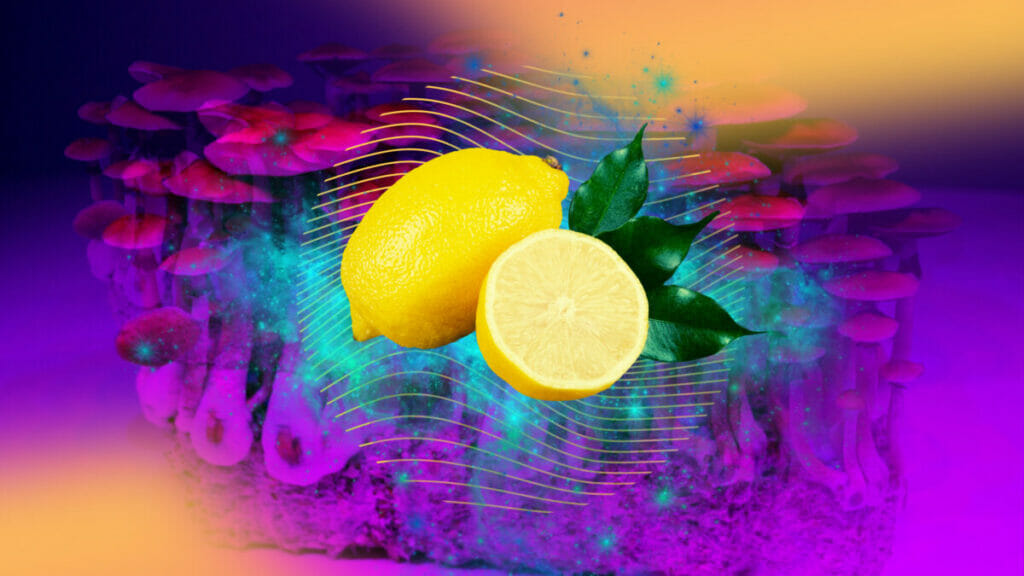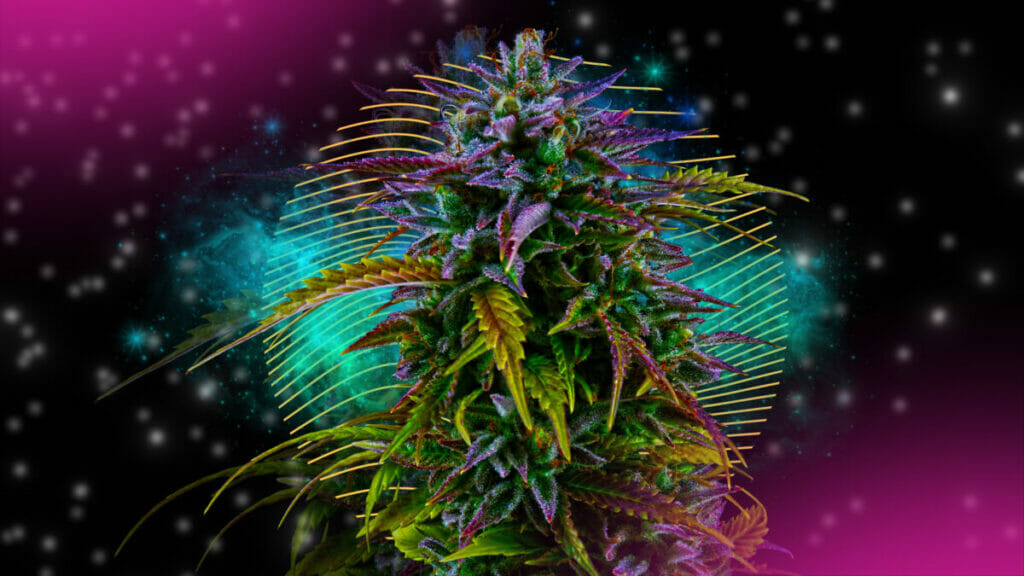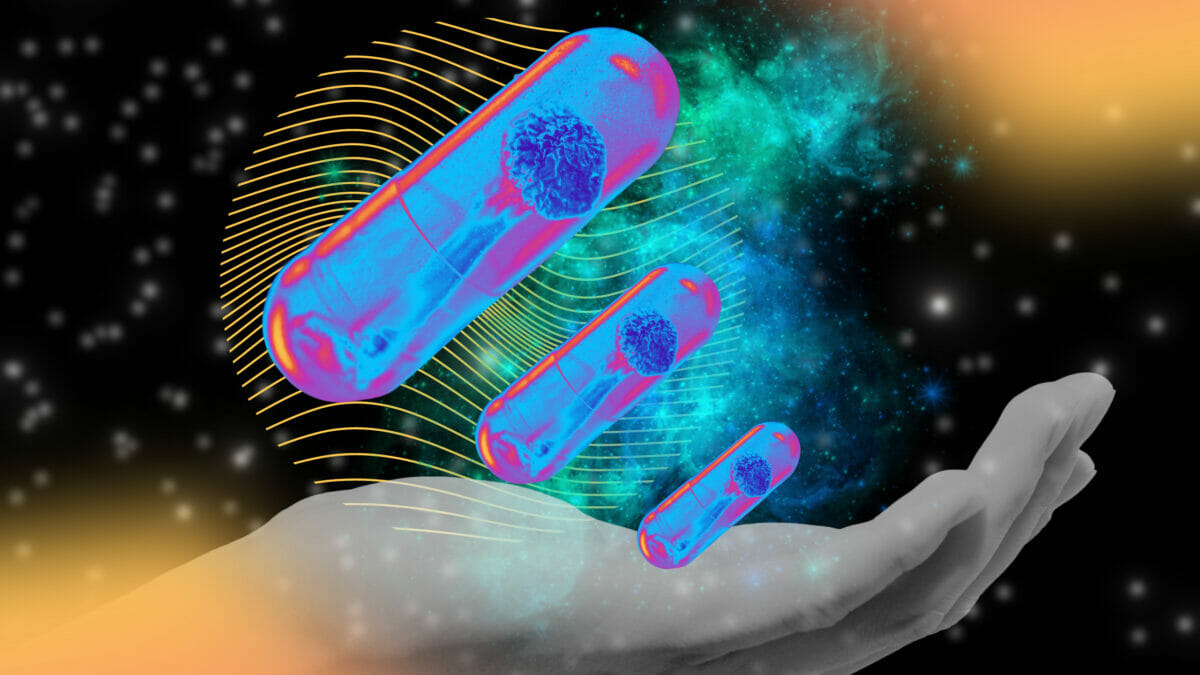Psilocybin-containing mushrooms grow wild on every continent except Antarctica. Over 200 species of fungi contain psilocybin, so our planet is unlikely to be in short supply anytime soon.
Nevertheless, we sometimes find ourselves in situations where we don’t have enough mushroom medicine. This could be because our access is limited, or because we’re dancing around legal limits on dosing.
Thankfully, there are some simple hacks we can use to get the most potency out of the medicine we have available.
The Role of Psilocin in Trips
Psilocybin is a pro-drug – a pharmacologically inactive substance when ingested. Upon consumption, it is metabolized into the compound psilocin – the active component responsible for your trip.
Stomach acid is essential for metabolizing the mushrooms into psilocin. It can take an hour or longer after eating the mushrooms for the trip to begin, as it takes time for the hydrochloric acid of the stomach to sufficiently break down the mushrooms and metabolize the psilocybin.
Unfortunately, many people nowadays have low levels of stomach acid. These include our seniors (hydrochloric acid production decreases with age), people on conventional reflux medications (which decrease stomach acid production), individuals with hypothyroidism (who have slower metabolisms), those with Helicobacter pylori infection (it damages the stomach lining and reduces acid production), and people with some other medical conditions.
Many hacks for speeding up the trip onset and making the mushrooms come on stronger are rooted in increasing hydrochloric acid levels and imitating the acidic environment of the stomach.
Light Eating for Quick Tripping
Eating a big meal before taking mushrooms slows the body’s metabolism of psilocybin to psilocin. That’s because the mushrooms you eat after a large meal go to the end of the line for processing. After the stomach is done churning out hydrochloric acid to bust up that double bacon cheeseburger, it’ll see what it can do for that last course of mushrooms.
Having less food in the stomach helps the digestive system get to the task of breaking down the psilocybin in the mushrooms, getting the trip started faster. It can also reduce the risk of nausea and vomiting.
Note: if you tend to get hypoglycemic (low blood sugar), then eating a little something to stabilize your blood sugar levels before, during, and after the trip is a good idea.
The Hidden Cost of Acid Inhibitors
Omeprazole, a medication that reduces stomach reflux, is one of the most commonly prescribed medications in the developed world nowadays. Sold as “the little purple pill” under the brand name Prilosec in the States, omeprazole temporarily alleviates the symptoms of acid reflux by inhibiting the stomach’s secretion of hydrochloric acid. Omeprazole and calcium carbonate tablets like TUMS should not be used for longer than two weeks at a time, but most people use them for months, and even years, not realizing the harm they’re doing to their health.
We need hydrochloric acid to properly digest our food and pull the nutrients out of what we eat. Without enough hydrochloric acid, we’re more likely to develop low bone density and dementia later in life. We’re also more likely to experience bloating, gas, and other digestive ailments because we can’t properly digest our food. To learn more about the risks of conventional reflux treatments and healthier alternatives, check out my article on TUMS and Prilosec.
Note: Even if you want to stay on your acid-suppressing medications, you might want to skip them on the days you trip.

Acidic Shortcut to Psilocybin Conversion, aka. the Lemon Tek
Lemon juice, lime juice, and vinegar mimic the acidic environment of the stomach, thus beginning the conversion of psilocybin into psilocin outside of the body before you ingest mushrooms. To prepare a lemon tek, simply chop up the mushrooms or grind them in a coffee grinder and let them soak in an acidic juice for about 15 minutes, then drink up.
This preparation is a great option for folks on antacid medications, the elderly, and those who tend to feel nauseous from mushrooms. It’s also a handy remedy for people who know that it takes a long time and a lot of mushrooms for them to start tripping.
Don’t leave the mixture to soak beyond 20 minutes, however, as more time can cause the psilocin to degrade. It’s crucial to note that lemon tekking is not permitted in Oregon’s psilocybin service centers, but luckily there are things you can do to increase your stomach acid levels at home before you head to the service center.
Naturally Increase Stomach Acid Levels
A variety of natural remedies can help increase the stomach’s production of hydrochloric acid. Here are some tried and true remedies, all of which you can do at home.
Drink lemon juice: Squeeze the juice of half of a fresh lemon into a small amount of water and drink it, ideally on an empty stomach, at least 15 minutes before taking psilocybin.
Apple cider vinegar: Drink one-fourth to one-half a teaspoon of raw apple cider vinegar diluted in a little water, ideally on an empty stomach, at least 15 minutes before taking psilocybin.
Kale: Chew on a little piece of raw (uncooked) kale, chard, or dandelion greens at least 15 minutes before taking psilocybin.
Herbal bitters: Herbal bitters can commonly be found in the health food store. My personal favorites include gentian, wormwood, and skullcap. As the name implies, bitter formulas taste bitter! They can be purchased in liquid or capsule format. While both work, I find that the liquid works better than the capsules. Bitter flavors on the tongue trigger the stomach to reflexively make more hydrochloric acid. Note that liquid bitters products are usually extracted in alcohol, so if you’re sensitive to alcohol, go for a glycerin preparation or capsules.
Betaine HCl: Betaine is the closest thing we have in pill form to what the stomach produces. This supplement is best used under the guidance of a naturopathic physician (ND) or herbalist. The gist to using HCl is this: start with one capsule at mealtime. At every meal, increase the dose by one more capsule (with breakfast take, one capsule; with lunch, take two; with dinner, take three). When you hit the dose that causes heat or burning in the throat or upper chest, stop. Reduce the dose by one capsule at mealtimes, and by two capsules on the day you take the mushrooms. For example, if you find that five capsules at mealtime cause burning and nausea, then take four capsules at all meals to help you digest your food. Then, on the day you trip, take three capsules on an empty stomach around the time of your mushroom dose.
On Antidepressants
Individuals on selective serotonin reuptake inhibitors (SSRIs) also sometimes need higher doses of psilocybin before they reach optimal effects. It’s worth noting that some professionals urge caution around combining antidepressants with psilocybin, but many of my patients have healed on mushrooms while on an SSRI without any adverse effects.
More research is clearly warranted on this topic.

The Role of Cannabis
Cannabis is an interesting (and controversial) adjuvant to psilocybin treatment, and one that doesn’t increase stomach acid levels.
Typically the way that cannabis is used in this context is to eat the mushrooms first, and then wait. If after an hour not much has happened, you can use cannabis to help you “launch.”
During my work in Jamaica, I saw many times that just a couple of puffs of marijuana helped people fully “take off” into their trip. The downside to using cannabis is that it can cause dry eyes, dry mouth, and dopiness – especially in people who don’t regularly use it. If you know that you need more than five grams of mushrooms to achieve your desired effect, then you may hit a glass ceiling at an Oregon service center. While the facilitator isn’t supposed to allow clients to take a hit of weed after they consume the mushrooms, what individuals do prior to entering the center is a matter of personal discretion.
Utilizing Breathwork to Amplify Psilocybin
Working with a practitioner who is trained in techniques like Holotropic, Reichian, or other types of breathwork can also help catalyze a psychedelic experience. Mushrooms pair nicely with “getting high on your own supply,” as the saying goes. Seriously: don’t underestimate the power of breath work. Even without a single milligram of psilocybin, breathwork alone is enough to send people into powerful, transformative trips.

Preparatory Sessions
The deeper you’re able to go in healing before taking psilocybin, the more you’re likely to get from the trip. In my own practice, I’ve found that the patients who do a couple of counseling appointments prior to tripping are the ones who have the most healing psychedelic experiences. There are many paths to “thinning the veil,” as I call it. People who are guarded – or have an iron curtain around their subconscious – need more medicine to help them “break through” their defenses. Patients who have a “thinner veil,” however, often just need a little bit of medicine to start the work.
On a recent retreat, we had a guest who wasn’t at dinner on the first night. When I went to check on her I found her in her room, sobbing. “I don’t know why I’m crying,” she moaned, “but I’ve just felt so sad ever since I unpacked my suitcase!”
The way I understood it, this guest’s healing had already begun. Just by arriving at the retreat site, the part of her subconscious that was holding things together had softened, allowing the dam of tears to break. Her veil, in other words, was thin. This guest took very little psilocybin in the days that followed, yet she went deep in her work.
If you don’t have a counselor to work with, then you can experiment with journaling, talking to friends, doing guided meditations, writing letters, or engaging in other practices to start letting repressed thoughts and feelings arise. I highly recommend the book The Artist’s Way by Julia Cameron, which offers deceptively simple prompts for journaling and reflection. These practices will likely help you get more mileage from your psychedelic trip. Or, as one of my friends often says, “the medicine is just part of the medicine.”
The Less-is-More Approach to Psychedelics
While we often glorify heroic doses, it’s important to remember that plenty of learning, growth, and healing can happen with small amounts of psilocybin, too. Personally, the most life-changing trip I ever had was on just one gram. On my last retreat, one woman cleaned childhood trauma out of her cells on just 2.5 grams, and in research settings, people report some of their most spiritually significant experiences on the equivalent of 3.5 grams of mushrooms. More isn’t always better, and, in fact, dosing medicine too high can increase the risk of throwing too much at the nervous system, which can be destabilizing and can cause more harm than good.
So, if you find yourself with less psilocybin than you initially thought you needed, try some of the hacks above. But even if you don’t, you’ll probably learn something.

